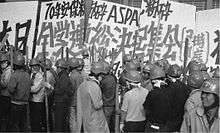Zengakuren
Zengakuren is a league of communist and anarchist students founded in 1948 in Japan. The word Zengakuren (全学連) is an abridgement of Zen Nihon Gakusei Jichikai Sō Rengō (全日本学生自治会総連合) which literally means "All-Japan League of Student Self-Government." Notable for organizing protests and marches, Zengakuren has been involved in Japan's Anti-Red Purge Movement, the Peace Treaty Movement, the struggle against the construction of Narita Airport and opposition to the Korean War in its first stage.
History
Although the association was formally organized on September 18, 1948, political movements among Japanese college students can be traced back to much earlier times.[1] While most writers recognize that the student political movement began hand in hand with the spreading labor movement after the First World War,[2] some writers say that this movement is as old as Japanese higher institutions. Akio Iwai, a member of the Japanese Communist Party (JCP) was the first president.[3]

In 1960, the league became divided after activities concerning the revision of the Japan-US Security Treaty. Three tendencies emerged:[3]
- Minsei: Groups affiliated to the JCP
- Sampa Rengo: An alliance of three factions all critical of the JCP: Japan Revolutionary Communist League, the Japanese Socialist Students League and the Japan League of Socialist Youth
- Marugaku: The Japanese League of Marxist Students consisting of a principle faction (Chukakuha) and a "Revolutionary Marxist" faction (Kakumaru)
Throughout the 1960s, Zengakuren organizations held protests against the U.S. invasion of Vietnam. In one notable case, U.S. President Dwight D. Eisenhower had planned to visit Japan during a 1960 tour of Asia, but so many Zengakuren turned out to protest at the airport that he decided not to land.[4]
Sources
- Shimbori, Michiya. Zengakuren: A Japanese Case Study of a Student Political Movement. Printed in: Sociology of Education, Vol. 37, No. 3, Spring, 1964 https://www.jstor.org/pss/2111956
- E.g., T. Kikukawa, Gakusei Shakai Undo Shi (The History of Student Social Movements) Tokyo: Chuokoron-sha, 1931
- Fuse, Totomasa (1970). "Le radicalisme étudiant au Japon". L'homme et la société (18).
- Kurlansky, Mark. 1968: The Year that Rocked the World. New York: Random House, 2004.
Bibliography
- Andrews, William Dissenting Japan: A History of Japanese Radicalism and Counterculture, from 1945 to Fukushima. London: Hurst, 2016. ISBN 978-1849045797
- Dowsey, Stuart J. Zengakuren: Japan's Revolutionary Students. Berkeley: Ishi Press, 1970.
External links
- Throw Out Your Books - website about far-left movement in Japan
- Official website (in Japanese) Japanese Communist Party - Democratic Youth League of Japan faction
- Official website (in Japanese) Japan Revolutionary Communist League (Chukakuha) faction
- Official website (in Japanese) Japan Revolutionary Communist League (Revolutionary Marxist faction) faction
- Official website (in Japanese) Sagadaigaku Gakusei Jitikai Renfaction